Church
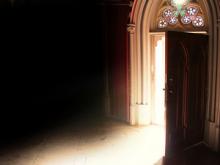
Recently, a large wealthy church decided to break up with my denomination. I’m not 100 percent sure I know why. But the no-regrets explanation they wrote implied that religious differences between us were too severe for them to stay committed to our relationship.
Religion has a way of making people do extraordinary things to create peace and unity. It also, as we know well, has a destructive capacity to turn people against one another. It can make us grip our convictions so tightly that we choke out their life. We chase others away, then say “Good riddance” to soothe the pain of the separation. Even more alarming, too many religious people insist on isolating themselves and limiting their imagination about where and how God can be known.
All these realities take on a sad irony when we read about God promising to be outside the walls, present with different people in different places. What does it look like when God defies the restrictions we presume are in place?

It’s sometimes cliché for Christians to warn about the dangers of idolizing wealth and money, but the negative impact it can have on our faith is often more subtle than we realize. Here are a few ways it covertly manipulates our spirituality
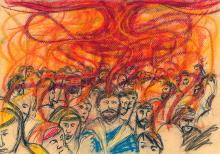
And church news is little different: pastor so-and-so is embroiled in a moral failing; church such-and-such fired its pastor over leadership differences; and the seminary down the street let go a professor over theological issues. The list goes on and on.
Isn’t it time for something different?
How about a little good news? What about a viral campaign about churches doing well? Well, here is my modest attempt to say a good word about our church community.
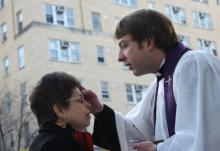
I’ll just say it: I thought “ashes to go” was a great idea.
Thousands of clergy and lay liturgists did “to-go” this year. From all evidence, it was a great hit.
Not everyone appreciated the innovation, of course. But then not every Christian appreciates a liberation-minded pope, or songs on projection screens, or preachers in jeans, or services at any time other than Sunday morning, or ditching denominational hymnals, or coffeehouses doubling as worship venues.
Rev. Joy Carroll Wallis, one of the first women ordained in the Church of England, is the real-life vicar of Dibley.

It seems like an eternal winter here in Detroit. The Associated Press, citing a National Weather Service analysis, reports Detroit is experiencing the most extreme winter of any city in the country. I don't know about that, but this winter is "getting real up in here."
At Holy Redeemer, the church just north of Detroit where I serve as pastor, the weather has impacted 9 of 12 Sundays since Dec. 15. It's hindered our ability to gather for worship, dented budgets, and made it hard to maintain community.
You can set your watch by the storms that arrive late on Saturday night and clear by Sunday afternoon.
Yet, time and again the congregation at Holy Redeemer manages to surpass my wildest expectations of faithfulness.
IT WAS AN average afternoon in the college town of Northampton, Mass. I was sitting at a local coffee shop sipping a latte when I overheard the conversation between two students comparing laptop decals.
“I’m really into the whole child soldier thing. This sticker is about that,” explained one young woman. The other pointed to an emblem on her laptop, remarking, “I’m more interested in the issue of sex trafficking, but I guess everyone is.”
“Yeah,” the other girl responded, “It’s kind of the sexy social justice issue.”
An intense interest in social justice has been a hallmark of the Millennial generation thus far. Within the church, there has been a clear departure from the traditional emphasis on evangelism alone to a broadening conversation about the necessity of addressing physical needs and human rights. Millennials have made great strides in engaging some of the world’s most pressing issues, but is the popularity of social justice a completely good phenomenon?
The Good
As a result of globalization, my generation is more aware than ever about the plight of those Jesus refers to as our “neighbors.” This awareness has heightened funding for NGOs, mobilized willing volunteers, and built pressure for better public policy. We have more knowledge regarding the injustices that people face all across the globe, and we’re often not content to simply cross to the other side of the road. It’s trendy to know and talk about justice issues, and this popularity has often led to action.
WHEN CHIEF MASTER Sergeant Harry Marsters returned in 2008 from his time in Iraq, he knew something wasn’t right. At 54, the 32-year veteran of the Air Force—with 27 years full time in the military and the remainder as a reservist with the Air National Guard—felt that as one of the “older folks” he knew what to expect upon return from his assignment with the communications squad at the Kirkuk Regional Air Base in northern Iraq.
Marsters’ squadron trained Iraqi forces in the operation and maintenance of aerial surveillance equipment on the base, which housed 1,000 Air Force and 2,500 Army troops. As first sergeant he acted as a liaison to the Air Force troops and ensured the well-being of those stationed there. It was a job he relished, pouring care into building connections with the airmen and women, spending time with the chaplains, and coordinating recreation and morale-building activities.
Though Air Force personnel never left the base, they were subjected to the ever-present threat of randomly timed mortar rounds launched by insurgents. They also took part in nighttime “patriot details” in which Air Force personnel and soldiers lined the base’s runway as the bodies of fallen soldiers were loaded onto planes for transport back to the United States. But Marsters says he was most upset by what he felt was harsh treatment of the Iraqi nationals who came to work on the base.
“They were treated like criminals,” he says of the extensive searches and intimidation Iraqis received when going through base security. “Everyone in Iraq is not evil, bad, and nasty. It’s a very small group of people who are raising hell and trying to hurt the country. The average person is just trying to make some money and take care of his or her family.”
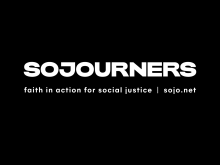
Nadia Bolz-Weber's church, House for All Sinners and Saints, is not your typical Lutheran church.
Nadia Bolz-Weber, pastor of the House of All Sinners and Saints in Denver, Colo., talks to CNN.
This President’s Day, about 20 church leaders, sympathizers, and undocumented immigrants were arrested in front of the White House as part of an act of civil disobedience to protest the nearly 2 million people who have been deported under President Obama.
The core group and about 40 supporters gathered around 1 p.m. on Monday afternoon in Lafayette Park in front of the White House. They held signs that said, “Praying for Relief” and “#Not1moredeportation,” and sang hymns in between short megaphoned speeches that told personal stories. They called for immigration reform. “Not one more, not one more,” they chanted together in both English and Spanish.
The event was organized by Bishop Minerva G. Carcaño of the United Methodist Church, who was the first Hispanic woman to be elected to her position.

FOR GENERATIONS, Native North Americans and other Indigenous peoples have lived the false belief that a fulfilled relationship with their Creator through Jesus required rejecting their own culture and adopting another, European in origin. In consequence, conventional approaches to mission with Indigenous peoples in North America and around the world have produced relatively dismal outcomes.
The result has subjected Indigenous people to deep-rooted self-doubt at best, self-hatred at worst.
One of the more egregious examples of the “conventional” approach in Canada involved the church-run residential schools. Indigenous children were taken from their families, prevented from speaking their native languages, and subjected to various other forms of abuse.
Isabelle Knockwood, a survivor of church-run residential schools, observed, “I thought about how many of my former schoolmates, like Leona, Hilda, and Maimie, had died premature deaths. I wondered how many were still alive and how they were doing, how well they were coping, and if they were still carrying the burden of the past on their shoulders like I was.”
Given the countless mission efforts over the past four centuries (which in practice were targeted not so much to spiritual transformation as to social and cultural annihilation), we might conclude that Indigenous people must possess a unique spiritual intransigence to the gospel.

I stepped off the elevator and was greeted by three men with hoodies in church yesterday. My shoulders tensed for a few moments. Growing up in New York City, I’ve been groomed in paranoia and 20/20 peripheral eyesight. Yet after taking a second look, I smiled as I admired the theater props: Three hooded figures containing the faces of Hillary Clinton, Jay Z, and Trayvon Martin, with a caption reading, “We are Trayvon Martin.”
Metro Hope Church meets weekly at Harlem’s National Black Theater, so our church gatherings can often be a dance in improvisation as we’re frequently welcomed by new sets. One summer we were greeted by a gigantic “tree” protruding from center stage. It made this preacher’s imagination run vivid with all sorts of sermon possibilities.
But the hooded figures that greeted me last Sunday were a tribute to Trayvon Martin called, Facing our Truth: 10 Minute Plays on Race and Privilege. This month also happens to be the month that Trayvon Martin was born, and a month for celebration of Black History. These convergences do not escape me, nor does the distinct mission of our church in Harlem.
No stranger to dialogue on race and privilege, our church will often reflect on Dr. King who once lamented, “We must face the fact that in America, the church is still the most segregated major institution in America … 11:00 on Sunday morning …we stand at the most segregated hour in this nation.”
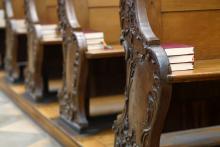
Tomorrow is Sunday. You know, the day when most Christians who bother to go to church with any regularity will get up on a perfectly good non-working morning and give their time to an institution that may or may not do them any favors. Catholics may have already gone to Mass on Friday or Saturday. The same with some people at Willow Creek.
The great thing about belonging to a Catholic Parish or a Mega-church is not having to go to church on Sunday. Okay, maybe there are other great things, but I think it's pretty swell.
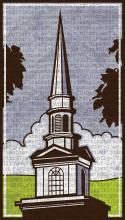
Earlier this morning, I saw a tweet from @JesusofNazareth316: Blessed are they who stop using the word “#missional," which caused me to post something on Twitter and Facebook asking people what their favorite church jargon is — mine being “Missional Imagination.” The response was unbelievable and also quite interesting.
I realized upon reading the #meaninglesschurchjargon tweets that the responses tended to fall into several categories:
1. Mainline Protestant church consultant/bad seminary class lingo. (“Missional imagination”; congregations as “centers for evangelical mission”; pastors as “transformational leaders”; referring to members as “giving units”; and churches “doing life together”) this language has a commonality with corporate jargon and like corporate jargon, refers to the culture and practices related to an organization.
IDEA: Let’s make sure that in seminary classrooms and at church conferences and in congregational life when we use a term or a phrase, that it points to an actual thing or person or event and is not just a string of words that sound like something meaningful but, in fact, lack real meaning. There is a reason that my computer does not recognize the word Missional. Try it at home. Go ahead. Type that shit and see.

The enclosed mall at Hillsdale Shopping Center had everything on a Friday morning: 1.3 million square feet of glistening space, top-drawer retailers like Nordstrom, reliable outlets like Macy’s, and teen-focused shops like American Eagle Outfitters.
It had everything except people.
The fabled mall — opened in 1954, enclosed in 1982 — felt like a ghost town. Or, in my frame of reference, like a big mainline Protestant church on a Sunday morning.
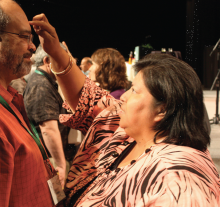
Bio: Carol Roth [Choctaw] is staff leader for Native Mennonite Ministries, a group that does liaison work between Native Mennonites and the broader Mennonite church. www.mennoniteusa.org/about/structure/related/
1. What are you most passionate about in your vocational role?
I’m passionate about working with the Native Mennonite people and helping them find a place in the Mennonite church. Unfortunately, some of the Native churches aren’t close to the Mennonite conferences, so you have to drive 800 miles to be connected to a conference, especially when you live on a reservation without internet or telephone. So my role is to connect the conference ministers and the conference with the Native churches and get them involved.
2. How did you come to straddle the Mennonite and Choctaw traditions?
When my twin sister and I were born [on a Choctaw reservation in Mississippi], my mom felt like she couldn’t give adequate care to two newborns. It happened that there were Mennonite missionaries who had moved nearby to help with the Choctaw group, and my parents asked if they could care for us for the winter. My parents realized how well they were taking care of us, so they asked if they could continue to care for us. My parents didn’t want them to adopt us, because they wanted us to keep our culture. So we grew up with the Mennonite missionaries, and then pretty much for all our lives attended one of the Choctaw churches.
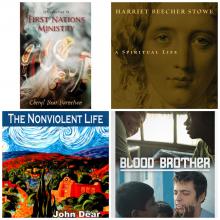
Faith and Reform
Writer and social reform Harriet Beecher Stowe’s controversial 1852 novel Uncle Tom’s Cabin brought many people to the anti-slavery movement. In Harriet Beecher Stowe: A Spiritual Life, biographer Nancy Koester illuminates the shifting role and expression of faith in Stowe’s personal and public life and work. Wm. B. Eerdmans
Falling into Love
A few years ago a young man named Rocky Braat left Pittsburgh to wander India; he’s ended up working for years in an orphanage for HIV-positive children there. His friend, filmmaker Steve Hoover, went to explore why. The result is a Sundance-award-winning documentary, Blood Brother. www.bloodbrotherfilm.com
Sojourners' online calendar features an image and prayer from various tribes around North and Central America that reflect an Indigenous understanding of God.